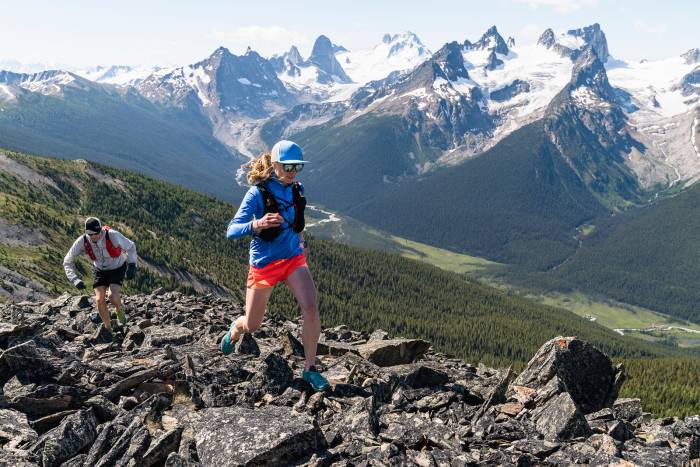By Sean McCoy
“I never really had a good reason to quit other than ‘this sucks,’ which isn’t good enough.”

I sent the above quoted text to my friend, GearJunkie founder Stephen Regenold, the morning after the 100-kilometer Ultra Race Of Champions as I lounged on a couch barely able to walk.
My first true ultra marathon among a slew of mid-length and stage races, I’d trained well for the physical, huffing and puffing aspects. The mental and logistical elements were another story.
As the final race in the Skyrunner World Series, the UROC 100k (62.2 miles) drew some big name stars of the running world to race from Breckenridge to Vail, Colo., on Sept. 28, 2013. I entered as a personal challenge and was nowhere near the elites.
(Check out page 2 of this post for more photos of the race course.)
Running an ultra as a mid-pack athlete is a matter of putting one foot in front of the other regardless of pain. It is also about not getting lost, eating enough food, remembering important gear at the right time, and keeping your head straight.
I got some of those right, staying on the well-marked course and maintaining a mostly-happy belly.

What I managed poorly was my mind. It tends to travel anyway, on daydreams to fantastical memories real and imagined, good and bad. The physical thrashing of the race seemed to give it a shove into uncharted territory. As I ran into an aid station at the 33-mile mark at the top of Vail Pass, dark thoughts began to swirl.
There, I saw another runner drop out of the race. “I’m throwing in the towel,” he said. I didn’t blame him. It seemed smart. It looked so easy.
Maybe it was the distraction, the thought of an easy exit from the pain of continuous running, that jarred my brain away from the tasks at hand. That aid station was my last chance to pick up gear before an 18.5-mile section with no crew access.
I forgot my headlamp, then remembered it a quarter-mile after the station. Too late.
I would be running in the dark.

My mind fixated on the mistake. I ran downhill on a paved trail in sunshine, clawed my way up a 2,000-foot climb, splashed along sloppy singletrack on the back bowls of Vail. The whole time I worried.
Standing in the sun with a cup of broth on the top of Vail Mountain, I asked how long I had until the cutoff. The volunteer’s answer was something like three hours.
The realization hit me: I had no reason to quit other than ‘this sucks,’ which is not good enough. I quit worrying and got a second wind.
But even as my feet lightened and the trail zipped along my mind traveled to its own weird world, and then the sun really was setting. I moved faster, but was ultimately caught in the dark with just the light of my iPhone.
I’m comfortable running at night but things still got weird quickly. I collected my headlamp, which was not particularly bright. As runners flashed their beams from behind, I caught glimpses of my own shadow.
Someone was standing in the woods.

An ultra marathon is more than a run. It’s a door into a world that people rarely see, a place where the weary mind plays tricks and pain is constant, a delicate brush with mortality in which perception is mutable.
That place, where the mind and the body don’t necessarily mesh, is where I went for those last 10 miles as my physical self climbed up the back of Vail Mountain, blew past the final aid station and ground down four miles of relentless switchbacks.
The shadow people waited for me in every flash of light from behind. Sometimes they were spooky and others they were a friendly volunteer. I’d shake my head each time they disappeared in my headlamp, then curse myself for my weakness.
“It’s only 62 miles,” I’d think. Lots of people run this distance or more.

But that, I think, might be the appeal of ultras. You just might never know what to expect. Like a psychedelic trip, long distance runs are unpredictable and fickle journeys of the mind.
I finally entered the finishers chute a little confused by the light. I was tired, a little delirious, but I’d made it.
Then I stopped in my tracks. A pair of eyes glowed from the darkness directly between the finish line and me. I’d run 100k through the mountains, and now there was some demon-beast in the way, just 100 feet from the finish.
Motion! My eyes adjusted a little and I made out the animal — a fox — as it lifted its tail and walked away from the finish chute. It was real and I was relieved.
My way cleared, I shook my head, laughed in disbelief, and jogged the final few feet across the line. My time was 15 hours, 41 minutes, and 1 second.
The men’s first-place runner, Rob Krar, had blazed the course in 9 hours, 29 minutes, with ultra luminaries Dakota Jones, Cameron Clayton, and Kilian Jornet close behind. Emelie Forsberg took the women’s crown in 12:06:33.
I savored a delicious hug from my fiancé and crew, Sarah. I smiled for a photo. It was 11 p.m. when I waddled slowly across a deserted Vail Village to the waiting car.
“Don’t worry, I’ve got princess parking,” she smiled. I have never been so glad to hear those words in my life.







